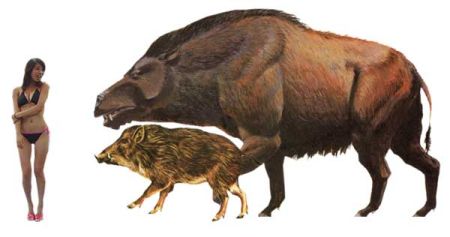Post by Babu Baboon on Feb 10, 2019 19:37:45 GMT -6

It looked suspiciously like a meat cache. In 1999, the Society for Vertebrate Paleontology was given a report on a strange bone bed found near Douglas, Wyoming. Huddled together in a big pile were the fossilized skeletons of at least six different Poebrotherium camels. Compared to the hump-backed beasts of burden we know today, these were relatively small, about the size of domestic sheep. The skeletons at this particular site were deposited around 33.4 million years ago, during the early Oligocene Epoch.
Many of the Poebrotherium specimens had retained their heads, necks, rib cages and front legs. But the back legs and the hips — in other words, the camels' meaty hindquarters — were missing. What's more, distinctive toothmarks riddled the bones. The evidence suggests that the pile of camel remains might've been a prehistoric meat locker, a place where some predators had dragged and stored their victims.
A look at the region's fossil record tells us there was a killer beast alive back then whose teeth perfectly match those gnarly bite marks. Its name was Archaeotherium. Weighing an estimated 600 pounds (270 kilograms) and measuring 4.5 feet (1.4 meters) tall at the shoulder, this creature would've been a sight to see. It walked on cloven hooves; its legs were long and thin; there were bony knobs on its jawbones; and the animal's lengthy snout was full of crushing teeth.
Archaeotherium belonged to a group of omnivores who patrolled Eurasia, North America and Africa for millions of years: These were the terrifying entelodonts.
Entelodonts have definitely won the awesome nickname sweepstakes: They're sometimes (informally) called "hell pigs" or "terminator pigs." Porcine as these creatures might appear, though, they weren't actually pigs.
Opinions have varied over where they belong on the mammalian family tree. Everyone agrees that entelodonts were artiodactyls, the order that includes whales and all the hoofed mammals with an even number of toes (camels, goats, hippos, etc.). What's up for debate is their placement inside that group. Scientists used to think that pigs and peccaries represent the entelodonts' closest living relatives. But that's no longer the consensus: A 2009 paper concluded that these beasties were actually more akin to hippos, whales and the long-extinct carnivore Andrewsarchus.
More than 50 entelodont species have come to light. The oldest that we're aware of was Eoentelodon yunanense, a pig-sized animal who rooted around China roughly 38 million years ago. Shortly thereafter, the group made its way to North America.
Early varieties tended to have short snouts, but within a few million years, natural selection lengthened their upper and lower jaws. Though the entelodonts started out small, huge ones quickly arrived on the scene. Archaeotherium, whom we met previously, was one of the first truly large entelodonts, but by no means was it the biggest.
As recently as 18 million years ago, the Great Plains of North America were home to the towering Daeodon. At its shoulder, this animal stood just under 7 feet (2.1 meters) in height — and scientists think it could've tipped the scales at 930 pounds (431 kilograms) or more.
Daeodon's head alone was 3 feet (0.91 meters) long. To support its weighty skull, the creature had powerful neck muscles connected to tall arches on the vertebrae in its shoulder area. So like a bison or white rhino, it may have had a visible hump on its back.
Your typical entelodont mouth had a combination of long canine tusks and blunt cheek teeth. No living mammal has quite the same arrangement of pearly whites. Judging by the anatomy of the snout and the bony surfaces where the jaw muscles would've been anchored, it's clear that entelodonts could open their mouths quite widely.
If the size of those muscle attachment points are any indication, the larger, long-snouted "hell pigs" delivered powerful bites. A 1990 study on the creatures' feeding mechanics concluded that entelodonts were capable of chopping up food by slamming their jaws together in a vertical motion. Alternately, by moving the jaws from side to side, they could also use the blunter teeth near the back of the mouth to grind food down.
Like real pigs, entelodonts were almost certainly omnivores. Wear marks on their teeth suggest the animals spent a lot of time gnawing on bones. Paleontologists speculate that entelodonts were efficient scavengers who probably took down live prey as well. Hard roots, eggs, fruits and vegetation may have also played an important role in their diets.
Entelodont teeth weren't just reserved for mealtime. Gouge-like toothmarks have been found on some entelodont skulls. Puncture wounds and healed-over scratches — sometimes measuring 0.78 inches (2 centimeters) deep — tell us that the animals occasionally fought by savagely biting each other on the face. A few animals bear tusk injuries around their eyes.
Being able to intimidate your rivals is an important skill for many territorial mammals. That might explain why so many entelodonts had long, flaring cheekbones projecting from the sides of their heads. (Another hypothesis is that these, too, were muscle anchoring points.) In addition, numerous species possessed bony knobs — or "tubercles" — on the undersides of their jaws. Those could've played a role in one-on-one combat.
The last entelodonts died out about 16 million years ago. No one knows why they went extinct, but the spread of new mammalian predators (like the extinct "bear dogs") could've had something to do with it.





